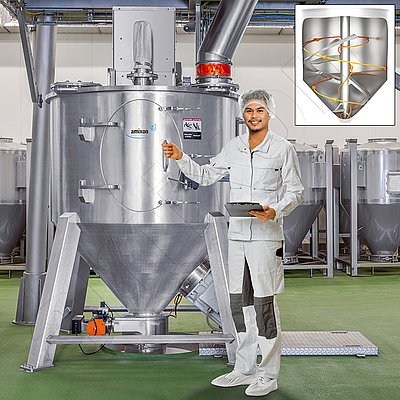Mixing

Mixing is the distribution of one or more substances in another substance. The substances differ from each other in at least one property. The substances can be solid, liquid or gaseous. Mixing processes can be discontinuous (batch mixing) or continuous (flow mixing).
In the context of this website, industrial mixing and homogenisation refers to disperse goods. These are powdery solids with the properties of typical bulk materials.
Powder mixers are used to mix dry powders. Neutral liquids can be added during powder mixing. In this way, powdery components of the powder can be bound. In other cases, the liquid is an active ingredient that needs to be evenly distributed in the powder.
Production plants that manufacture powdered goods consist of a large number of other process engineering systems. The mixer is only one link in the chain; the mixer is usually located upstream of the filling or packaging system.
The mixing process serves to increase the value of the end product. Typical quality criteria for end products in powder form are listed below:
- Powder is absolutely homogeneous
- Particle structure is retained
- Powder is dust-free
- Powder flows well
- Powder is not heated, but cool
- Powder is dry to the touch
- Powder is stable in the long term
- Powder does not tend to clump
- .....
- ...
The factors influencing the end product are manifold:
1) Mixing systems
In principle, powder mixers can be manufactured anywhere where classic mechanical engineering is practised. This is why there are hundreds of suppliers worldwide. However, if you focus your search on specialised machine manufacturers that only produce precision powder mixers, the number of suppliers is significantly lower.
Precise powder mixers are known as precision mixers. They have important characteristics:
- They have rotating mixing tools
- They mix (almost) free of dead space.
- They achieve ideal mixing qualities.
- They can be used universally for almost all powder mixing processes.
- They also work when the mix flows poorly.
- They have a sufficiently hygienic design.
- They work largely contamination-free.
- They are designed to be gas-tight. Dust does not get into the environment, nor do foreign substances from the environment get into the mixing chamber.
- They are easy to clean.
- They fulfil the requirements of environmental protection and occupational safety.
- They generally have a long service life.
Powder mixer manufacturers who specialise exclusively in the manufacture of precision mixers have also specialised in certain types of precision mixers. To a certain extent, they are trendsetters for their further development:
- Stationary mixing chamber, internally rotating mixing tools
- Horizontally mounted mixing tool
- Mixing tool mounted vertically
- Mixing tool mounted at an angle
- Vertically mounted mixing tool
- Mixing chamber mounted at an angle
- One or more mixing tools in the mixing chamber
- Fast rotating mixing tool (centrifuging and whirling)
- Slow mixing tool (push mixing) rotating
2) How the mixing process is carried out
- At what speed are the mixing tools operated?
- When is which mixing tool switched off or on?
- In what order are the various components fed into the mixer?
- Is the product added at a standstill or with rotating mixing tools?
- What is the temperature profile during the mixing process?
- What type of liquid addition is used?
- How long does the mixing process take?
- Does the mixing tool(s) have to rotate so that the mix can be emptied?
- How long does the emptying process take?
- How great is the risk of unintentionally influencing the particle structure during the emptying process?
- What degree of emptying can be achieved?
- Can the mix be discharged in portions defined by weight?
In industrial practice, it is advantageous to have precision powder mixers that offer maximum flexibility in many respects.
One example of this is the AM conical mixer:
- The batch size of a conical mixer (AM) can vary from 10 % to 100 % of the nominal volume.
- The AM 100 size can mix batches from 10 to 100 litres. An AM 30 000 conical mixer can mix batches from 1,500 to 30,000 litres.
- Free-flowing powders are almost completely discharged.
- Residual discharge can be up to 99.98 % and better.
- One and the same mixer can homogenise extremely gently
- The same mixer can also be used for intensive deagglomeration by changing the operating mode.
- It can also mix highly viscous liquids into powders.
- It can crush agglomerates.
- It can be wet-cleaned fully automatically.
The list of examples could go on and on:
- Activators or catalysers,
- antibiotics,
- infant formula,
- baking agents
- bacterial cultures, preservatives, spices,
- battery compounds
- Doping of colourants
- Fertilisers
- Duromers and elastomers,
- Colouring,
- FDA-compliant masterbatches for medical technology,
- fire extinguishing powders,
- High-temperature materials,
- hydrocolloid preparations,
- inhalants
- instant pudding,
- Iodisation of table salt,
- coffee, sports nutrition,
- Ceramic powder as a dielectric in electrical capacitors.
- Cereals,
- organic and inorganic colour pigments,
- Plant protection products (fungicides, herbicides, insecticides),
- Phosphoric acid derivatives for cola drinks,
- pigments,
- Powder coating dry blends with resins and fillers,
- raw material preparation,
- painkillers
- Explosives,
- superconductors
- tobacco
- Release agents,
- dried soups
- Vitamin preparations etc.
- Detergents,
- Homogenising active ingredient mixtures (highly concentrated) as premixes and dispersing them in carriers:
- Much more
Learn more about the diverse techniques and applications of industrial powder mixing.
Many manufacturers of precision powder mixers have pilot plants and test mixers. Tests should always be carried out when a new product is launched on the market or when a new powder mixer is to be purchased.
